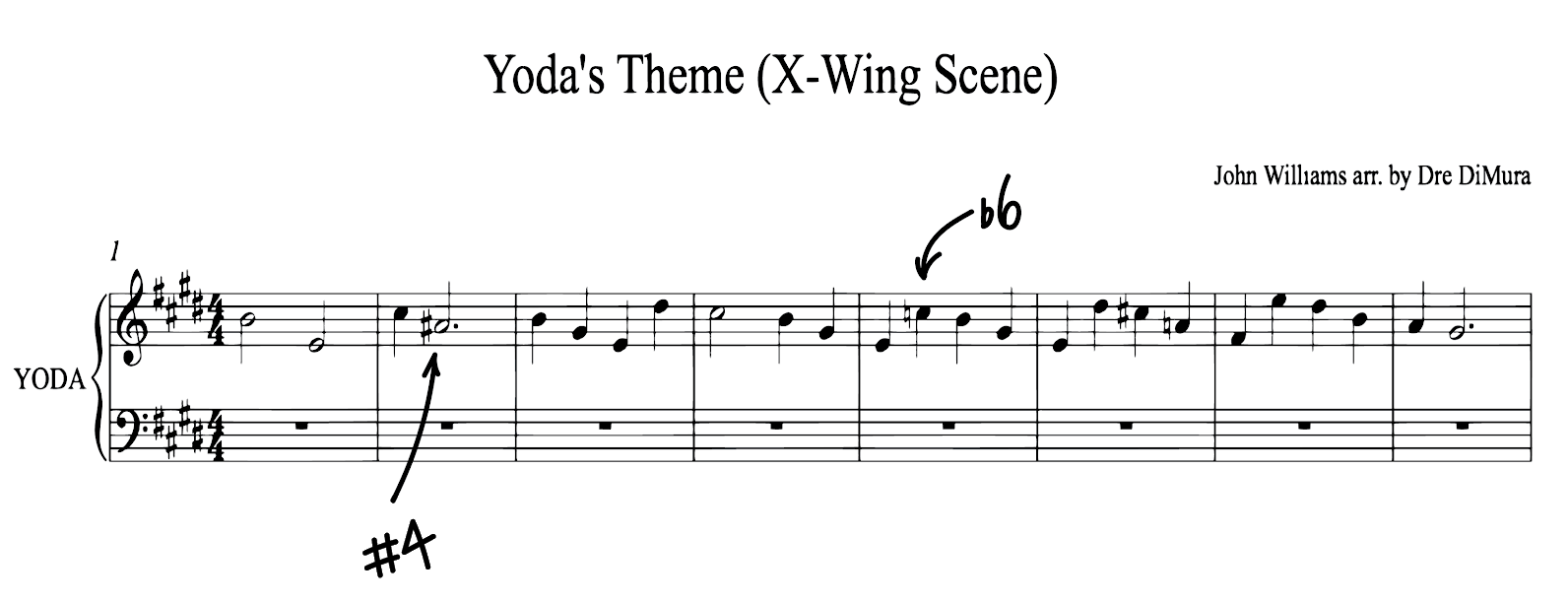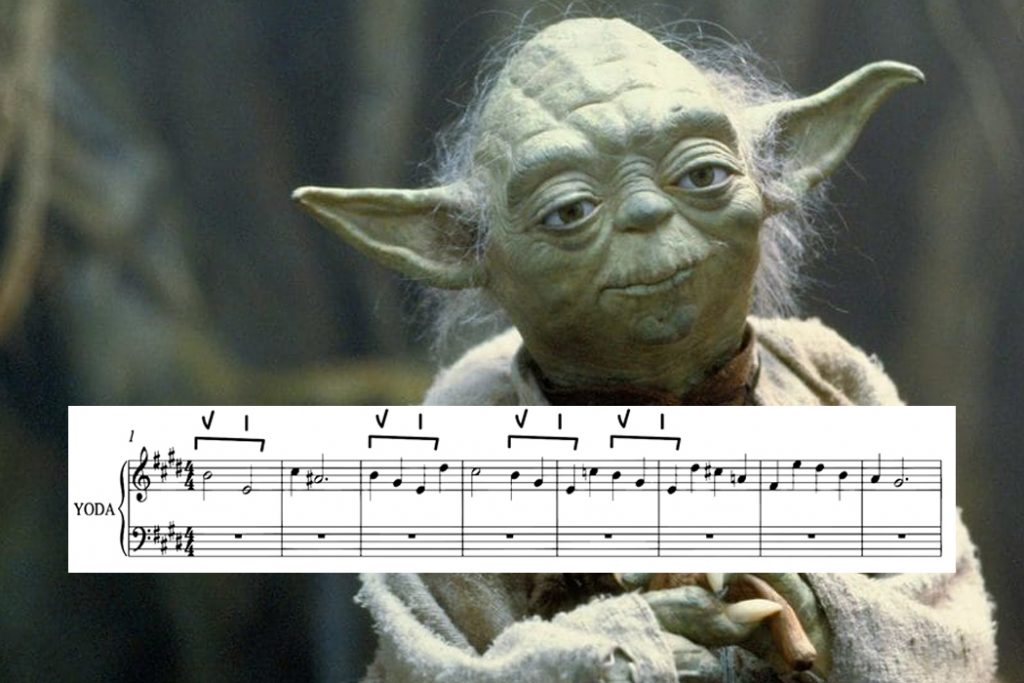+ Soundfly’s Intro to Scoring for Film & TV is a full-throttle plunge into the compositional practices and techniques used throughout the industry, and your guide for breaking into it. Preview for free today!
The 48th Star Wars movie just dropped, and the world just can’t stop talking about Baby Yoda. I can’t wait to see how many newborns get dragged around by mom and dad with green face paint and rags next Halloween!
Along with cohorts Hans Zimmer and Danny Elfman, John Williams has written the book on “epic” since beginning his career in 1952. Williams has won 24 Grammy Awards, and 51 Academy Award nominations, and his 1977 Star Wars score was named “The Greatest American Film Score of All Time” by AFI.
A brief aside…
We recently launched a video on our YouTube channel that teaches any musician how to memorize every common note interval using only movie themes from John Williams scores. It’s…pretty rad. Musicians, composers, and curiosity-junkies, check it out and subscribe if you like that sorta thing!
But, in this article, we’re going to use Williams’ “Yoda’s Theme” leitmotif to explore how upper and lower neighbors can help us write modal melodies while remaining rooted in diatonic harmony. “Yoda’s Theme” is an exercise in exploring this concept in an elegant and musical way. The example we’ll use for this analysis is taken from an eight-bar excerpt of the “X-Wing scene” in The Empire Strikes Back.
You can follow along in the video below from 3:21 – 3:47.
Here is a transcription of the basic melody from that section with a simplified rhythm (there is a whole mess of rubato on the recording).

There are several indicators throughout the theme that establish “E” as the key center; most clearly the last phrase, which goes E, D#, B, A, G#. Here we have the major seventh, perfect fourth and fifth, and the major third. Harmonically this is a II- V I progression. See the turnaround during the final bars.
Also note that the perfect fifth, E to B, creates stability and is restated four times to serve as a pivot point for the introduction of the upper and lower neighbors.

Using the chromatic upper and lower neighbors of the dominant (B), Williams crafts this brilliant melody which implies modality but remains firmly rooted in diatonic harmony. In this case the upper and lower neighbors are the #4 (A), and the♭6 (C). These can be found here:

To understand how we can analyze this technique using modes, keep reading!
Mode 1) E Lydian (bars 1-4)
E F# G# A# B C# D#
The theme starts on the dominant (B), followed by the root (E). The strong relationship between the fifth and the tonic we touched on earlier gives Williams the foundation he needs to play. The unique quality of the Lydian mode lies in wait!
First, Williams chooses C#, which along with the B and E in the first bar, outlines an E6 chord. This acts as a bit of a tease, as the more information belonging to E Ionian/major that Williams provides, the more unexpected the sharp fourth (chromatic lower neighbor) on beat 2 is.
In bar 3, Williams expands on the idea introduced in bar 1, this time descending through a complete E major triad (which includes the major third), then spelling out that chord more fully by adding the seventh and the sixth, further fleshing out the E6. You could say that the tonality shifts to Ionian here, except, there is no A-natural to nullify the A# in bar 2 (coming later).
Williams ends his phrase on the sixth. By delaying resolution to a primary chord tone, Williams illuminates the feeling of awe and disbelief that Luke is experiencing as Yoda uses the force to recover his X-wing. This creates both suspense and hope all at the same time, something to look forward to.
Mode 2) E Mixolydian♭6 (bar 5)
The next phrase that begins on beat 3 of bar 4 is absolute magic. Williams uses the♭6 (C-natural, the upper neighbor) as he continues to expand on the descending V – I triadic idea. This implies E Mixolydian♭6, the 5th mode of the Melodic Minor scale. The presence of the perfect fifth (B), tells us that this phrase is borrowed from the Mixolydian♭6 mode as opposed to say, Lydian augmented. This is a beautiful mode and in expert use here, acting as a lovely transition from the Lydian tonality in bars 1-4 to standard E Ionian in bars 6-8.
If you want to hear a contemporary example utilizing this mode, listen to “Single Ladies” by Beyoncé. Here is a great exploration by YouTuber Adam Neely:
Mode 3) E Ionian (bars 6-8)
The last three bars are firmly in E Ionian. Because of the natural fourth (A-natural) in bars 6 and 8 and the major seventh (D#). Williams outlines an F#m6 chord in bar 6, which functions as II- in E, this further supports the diatonic framework that we’re working within, and at the same time, creates that nifty II- V I turnaround.
The A-natural is also a common tone between E Mixolydian♭6 and E major, and makes for a smooth capitulation as Yoda triumphantly rescues Luke’s ship and the story progresses.
Contour
The melodic contour of this theme serves and illuminates the material within the film; it’s very much a leitmotif. The melody descends but the starting point of each subsequent phrase climbs upward. This pairs well with the action in the film as the X-wing itself is rising, Yoda’s arm is rising and Luke stands up.
The only line in which Williams breaks from this pattern is in bar 5 when he begins the descent on the♭6 — this creates a flash of uncertainty for the audience as we wait with bated breath for Yoda to successfully save the X-wing.
It’s also no coincidence that Williams chooses to introduce the lower neighbor first and the upper neighbor next, as this remains congruous with the theme of elevation.
The Takeaway
When we establish a strong I – V relationship, we create a framework that allows us to explore other tonalities using modes borrowed from parallel keys. By visiting these chromatic color tones in passing, and not straying too far away from the tonal center, we create music that is active, but carries a stillness that can evoke a lot of emotion when used with taste and intention.
We also see how effective chromatic upper/lower neighbors can build tension over a static chord (I) that leads us to a powerful resolution (II- V I). It’s beautiful that something as simple as a II- V I can be so absolutely breathtaking!
I hope this analysis of “Yoda’s Theme” was helpful and interesting and that it leads you to new musical discoveries in your composition and songwriting!
Have you checked out Soundfly’s courses yet?
Continue your learning with hundreds of lessons by boundary-pushing, independent artists like Kimbra, Ryan Lott & Ian Chang (of Son Lux), Jlin, Elijah Fox, Kiefer, Com Truise, The Pocket Queen, and RJD2. And don’t forget to try out our intro course on Scoring for Film & TV.





